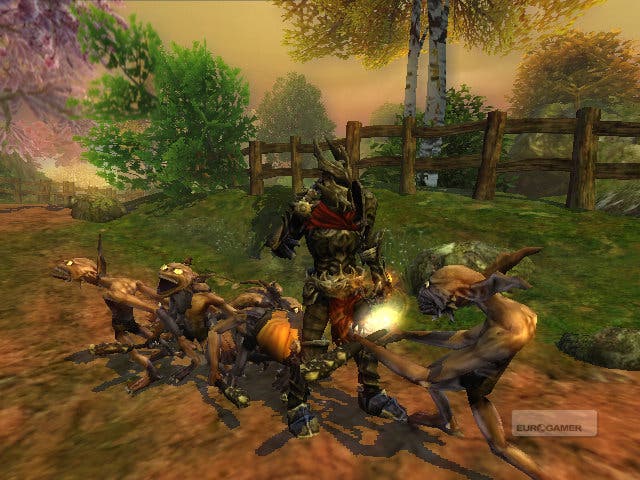Overlord: Dark Legend
Evil twin.
One notable change from the original is that the souls you harvest now count towards a global stock of minions, rather than each enemy's soul being specifically colour-coded to correspond with each of the four minion types. This simple design decision instantly makes the game a far more accessible and less frustrating affair, because you no longer have to worry about running out of specific minion soul types as is always the case in Overlord 1 (and II, actually). This generally ensures that no matter what, you'll always have enough minions for the task at hand - especially as the game is generous with the number of souls it spits out of dead enemies compared to Triumph's original take. Towards the conclusion of Overlord: Dark Legend, it's not uncommon to have several hundreds of minions in stock - something that would take an awful lot of hard work to achieve in the other console versions.
But while smaller, focused battles and the simplicity of minion-harvesting makes for a pleasantly meandering Overlord experience, you're always wondering when the game is going to crank up the challenge a bit. You rattle through quests in no time, and the thinking required is limited to placing red minions on a vantage point to rain down fireballs on enemies below, or using the blues to wade through a stream and turn a crank or push a block, and things like that. Compared to the uniformly excellent action-strategy blend in the parent titles, this is lightweight. Admittedly Codies is aiming for a slightly different audience, but some of the other tweaks it made to the harvesting system and the generous checkpointing ought to have given Climax license to be a little more taxing with its level design - at least after the first hour or so.
As it is, Overlord: Dark Legend resolutely refuses to provide a stern test at any point during its 8-10 hour long quest, and additional new features such as the ability to throttle minions and use them as bombs only comes into play a couple of times, while the growing roster of spells that the Overlord accrues can pretty much be ignored altogether, unless you fancy turning enemies into sheep. Likewise, the ability to level up your armour, weapons and minions feels a bit underplayed. Money becomes so plentiful so early on that you can basically max out everything in no time, neutering the challenge even further.

In addition to being served up a more lightweight challenge, Overlord: Dark Legend also suffers a notch in the technical stakes, with the gloriously detailed environments of the originals not quite making the transition to the Wii's 480p. While some of the levels you visit fare better than others, the engine tends to struggle when rendering lush foliage, and can end up looking garish and blocky, with accompanying frame-rate struggles. At best, the Greenvale fantasyland still looks gorgeous and inviting - indeed, the character and level design can be outstanding. Tackling evil gingerbread men is one highlight, as you smash through the candy-striped world of an evil witch, but it's an uneven experience on the whole. In addition, the largely useful automatic camera system can freak out if you happen to stumble into a corner of the level that it doesn't like, somewhat adding to the impression that the game could have benefitted from a little extra polish here and there.
As an introduction to the Overlord brand, there's no doubt that Overlord: Dark Legend does a fine job. With its joyfully evil brand of warm humour enlivening every encounter, it's a game that makes you feel good about being bad. And with slick controls and a satisfying blend of action and strategy, it's a game that's never less than enjoyable to play. But while it provides superior controls and less frustration than Overlord II, it regrettably falls down by failing to offer enough of a concerted challenge. There's a wealth of promise here, but maybe we'll have to wait for the next Wii version to see it live up to that.

